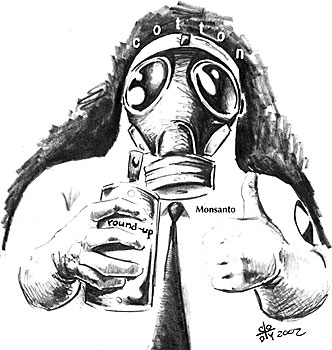
Illustration by Cody Angell
|
By Jessica Lee
Arizona Daily Wildcat
Tuesday October 15, 2002
Fluffy, white balls of cotton drifted across I-10, catching in the dried weeds on the side of the road. The cotton harvest had begun. Last Wednesday, I got a chance to visit the 2002 University of Arizona Cotton Field Day at the Maricopa Agricultural Center (MAC).
Two aspects of the day disgusted me ÷ Monsanto Corporation-patented cotton and the 2002 Farm Bill.
The UA was given roots when President Abraham Lincoln signed the Morrill Act of 1862, giving 30,000 acres of land to each state to be used to house and fund a land-grant institution. The bill set the foundations for mass education of the working class in areas of agriculture, mechanics and military.
In order to connect the common workingman to the wisdom-mecca of the
university, the 1914 Smith-Lever Act created cooperative extension services. Experimental research stations, including the MAC, were established as part of the education, research and service land-grant mission.
To continue that duty of widespread agricultural education, the Cotton Field Day event was to inform mainly Arizona farmers about the current cooperative research being conducted on cotton by the UA Research and Extension faculty, USDA-ARS personnel and agricultural industry professionals.
Tainting cotton, UA
Maximizing cotton yields was the topic of the air-conditioned bus tour of the experimental fields. Research included testing chemicals that induce leaf defoliation and desiccation ÷ the killing and removal of the leaves so they will not get mixed in with the cotton harvest. Other tests included the timing of the boll-break, quality of the fiber, the height of the plants and the exact amount of herbicides, pesticides and insecticides needed in order to reduce environmental impacts.
The most progressive investigation is that of genetically engineered cotton. For example, Bt cotton is resistant to worms. Monsanto leases land at MAC where they conduct insect and herbicide-protected hybrid cottonseed research. The presence of this company on UA land is dirtying the university.
Monsanto began as a pharmaceutical company at the turn of the century, but turned toward agrochemicals with the onset of World War II. It entered the market with insecticides, and later turned to herbicides and pesticides.
Monsanto commercialized the herbicide glyphosate, better known as Roundup, in 1974; but, interestingly, it killed everything ÷ even the crops. But by the late 1980s, Monsanto research promised biotechnology-based products that would be resistant to their own Roundup formula.
Roundup Ready cotton ÷ glyphosate-tolerant cotton ÷ was placed on the market in 1997, two years after Bollgard insect-protected cotton was commercialized.
The problem? Monsanto owns the DNA-sequence of the genetically modified plant. Thus, the patent is phrased such that Monsanto is in the position to control the complete production process ÷ breeding, sowing, harvesting and marketing of the cotton products.
So, if a farmer wants to use Monsanto brand-name seeds, not only do they have to use their Roundup herbicide, but the farmer legally cannot harvest the seeds to use next season. And if they don't want to re-buy? Too bad, because their Roundup-laden soil will not grow anything. And what happens if pollination crossbreeds one organic crop with a genetic crop? The organic farmer would be growing a Monsanto product illegally, and could be prosecuted in criminal court.
Just ask Percey Schmeiser, a long-time Canadian canola farmer. Monsanto just confiscated his farm.
Want to lobby the Secretary of Agriculture, just like Monsanto has been doing for years, to press for change? Too bad, because President Bush selected Monsanto executive Ann Venamin to be his Secretary of Agriculture for his administration.
Subsidizing the rich
At UA Cotton Field Day, a symposium was offered to present 2002 Farm Bill sign-up requirements to cotton farmers. The bill, signed in Bush, will increase spending on agriculture by 80 percent, or $8 billion, a year.
Most affected will be grains and cotton, both of which are Africa's most important crops. These subsidized crops enter the market and depress the global prices, hurting poor countries that really have the competitive advantage.
According to Newsday, Peter Rammatula, president of South Africa's main farmers' union, is distraught. "We want an even playing field. How can a farmer in Africa compete against the deep pockets of the U.S. government?"
Besides forbidding a global free market for cotton, most of the subsidies will benefit the top richest corporate farms. The cowboy hat folk at the symposium are not going to benefit much.
And for cotton's target price of 72.4 cents per pound, the amount of precious Arizona water needed does not justify the crop's existence here.
It is time to kick not only Monsanto off the UA farm, but cotton as well.

